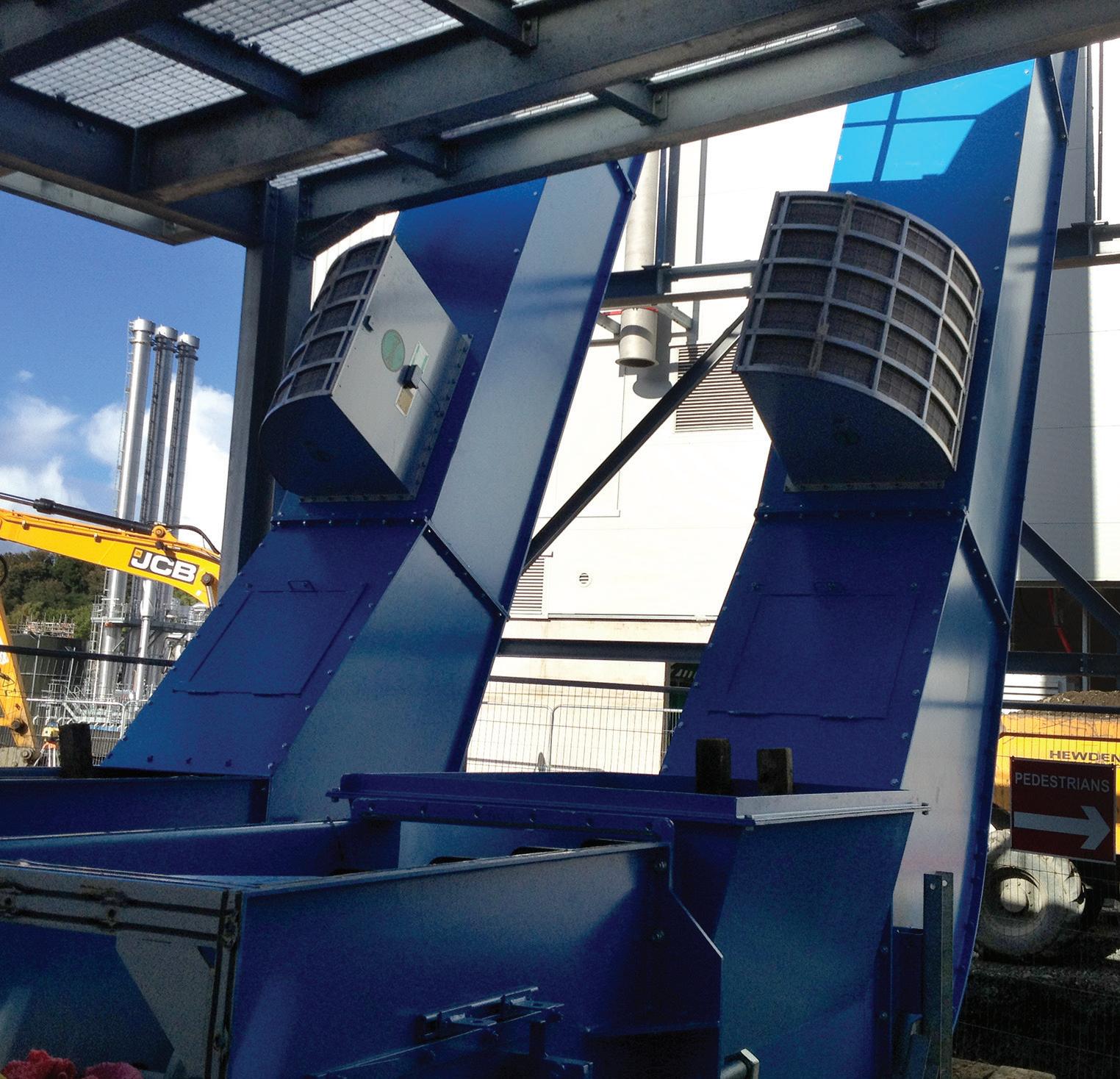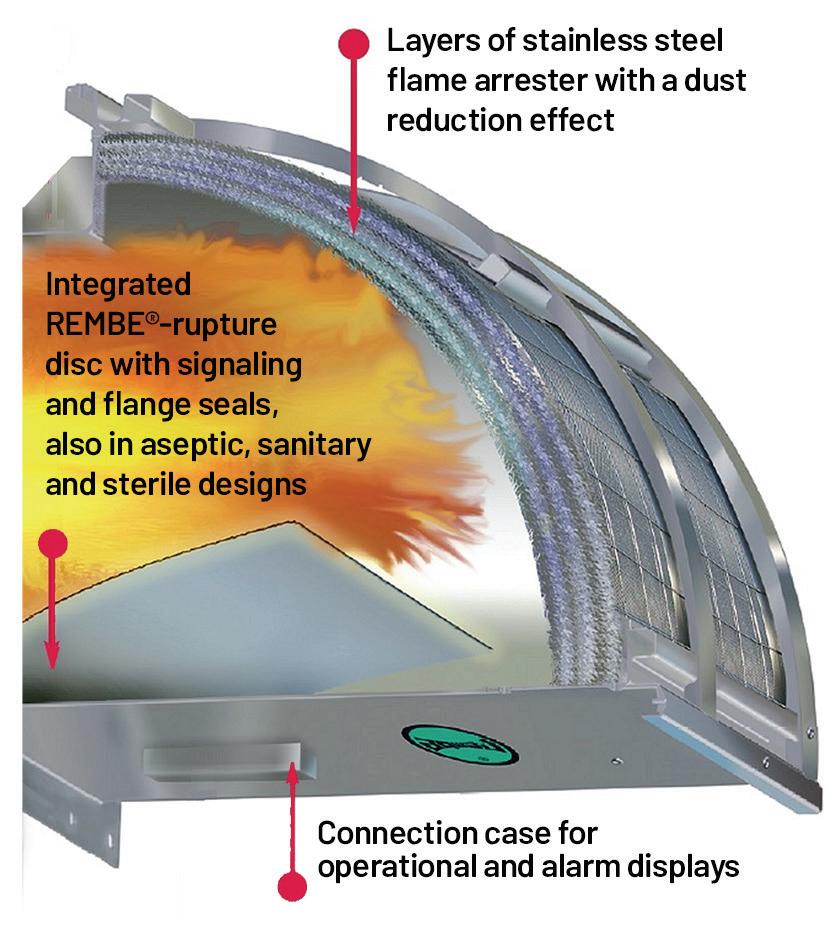
4 minute read
PROTECTION
REMBE Q-Box flameless explosion protection installed on covered conveyors. PHOTO: REMBE
When passive explosion venting is needed inside a pellet mill or in areas where conventional venting is unsafe, REMBE has a reliable solution. Flameless Explosion
Protection for Combustible Wood Dust
BY JERAMY SLAUNWHITE W ood dust is not only a nuisance to industrial facilities but can also be deadly. Combustible wood dust can cause explosions in equipment and building compartments under specific conditions. The five elements of a dust explosion are: fuel, oxygen, ignition source, suspension of the fuel in a dust cloud and containment. Removal of one item eliminates the chance of a combustible dust explosion. Eliminating fuel, oxygen or the ignition source prevents combustion from occurring. Removing suspension reduces the rate of combustion and possibly Slaunwhite A functional illustration of the REMBE Q-Box flameless vent. IMAGE: REMBE

fuel ignition. If containment is not present, a flash fire or deflagration can still occur but pressure will not accumulate. It is the accumulation of pressure in a confined volume that can lead to catastrophic failure or an explosion.
Among the various methods to protect against a dust explosion, deflagration relief venting is the simplest and most common. Deflagration venting consists of a designed weak point in the protected enclosure, typically a door or panel, which quickly opens at a predefined pressure. This allows the internal pressure and active deflagration generated by rapid combustion of dust to exit the vessel before accumulating and exceeding the enclosure failure strength. Deflagration vents are sized and selected by knowledgeable application specialists according to a standard such as NFPA 68 (Standard on Explosion Protection by Deflagration Venting). Deflagration venting is a reliable, passive method of explosion protection for exterior vessels located in unoccupied areas. Extreme care and caution must be considered with respect to the orientation of deflagration vents as the effects of successful explosion protection include rapid discharge of pressure and fireball from the vents up to as much as 60 meters. An open deflagration inside a facility not only poses a risk associated with fire and pressure discharge but also the potential of a secondary explosion on the building itself from residual dust layers.
Flameless venting was invented by REMBE in the 1990s as a safe, passive explosion venting solution for vessels located inside facilities or in areas where conventional venting was not safe. Flameless venting is a two-part explosion venting system: rupture panel and flame arrestor. The rupture panel functions like a conventional deflagration vent panel that opens under the internal pressure rise of a protected vessel. The flame arrestor is a matrix of stainless steel mesh that allows the vented fireball and gases to pass through to the exterior, but not before removing the flame. This is accomplished through heat transfer from the burning fireball to the layered network of steel mesh. The high surface area of the mesh rapidly absorbs the fireball heat energy below the flash point, allowing only gases to exhaust. The mesh also serves as a retention barrier for unburnt dust expelled from the vented vessel which would otherwise continue to fuel a propagating fireball.
Flameless vents effectively control the external hazards resultant from conventional explosion vents, including fireballs and potential vent panel and unburnt material projection. It is important to note that a complete explosion protection strategy must also include isolation to prevent an explosion from propagating to other interconnected equipment and areas.
The mesh of a flameless vent imposes some restriction to venting the deflagration. This must be accounted for in determining the appropriate relief vent area to protect the vessel. Flameless vents must be tested and certified by a credible organization for suitability and reliability under various parameters, including the combustible dust material, vessel size, pressures and effective vent area compensating for the restriction imposed by the mesh. The European standard EN 16009 is the generally accepted test standard for flameless venting devices and meets the certification requirement of NFPA 68 for flame arresting and particulate retention venting devices.
Flameless venting is extremely advantageous in the wood industry, especially in biomass, pellets and panel board processing involving significant handling and manipulation of fine, dry wood material. Typical equipment with explosion hazards often lo
cated inside plants include covered conveyers, dryer systems, hammer mills, bins, sifters and even silos, cyclones and baghouses located in occupied areas. Flameless venting offers a safe, reliable explosion protection solution with virtually no maintenance. Flameless vents are easy to install and can be applied to new equipment or retrofit on site.
In the event of an explosion, it is critical to minimize down time; flameless vents are designed with this in mind. In addition to protecting the integrity of the equipment, flameless vents can be reinstalled following a visual inspection, washdown and spare rupture panels from the plant stores. A protected process could be back online within hours following an explosion without expensive, time-consuming technician startup required by some other explosion protection systems.
Author: Jeramy Slaunwhite, P.Eng North American Explosion Safety Consultant REMBE Inc. 902-220-6396 jeramy.slaunwhite@rembe.us
T +1 704 716 7022 T +49 2961 7405-0
© REMBE® | All rights r eser ve d
PROTECT YOUR PLANT!


Consulting. Engineering. Products. Service.


· Over 45 years of innovation in comdust explosion protection. · Venting and isolation to protect personnel and plant. · Customized indoor/outdoor protection for dust collectors and more.
| Charlotte, NC 28217, USA | info@rembe.us | www.rembe.us Inc.





